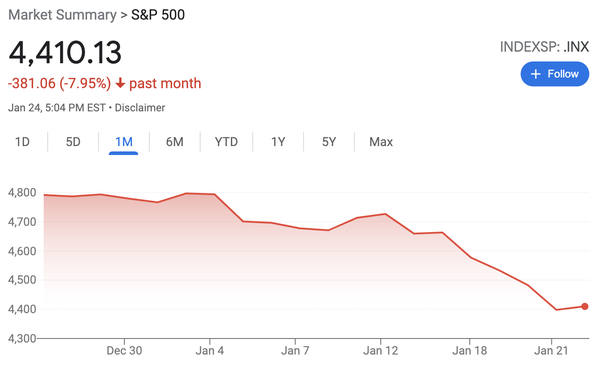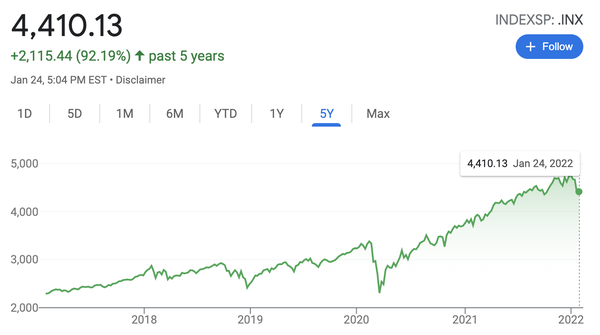In times like this…
25 January 2022
Hey, The Investor’s Podcast Network Community!
If you are active on social media in the community known as “FinTwit” or have flipped on CNBC in the past week, you’ve likely seen that there’s a bit of panicking going on right now surrounding the stock market. If you asked one hundred different people, they’d all have a different opinion on why the market is down, what’s happening, or where it’s going, but the reality is, no one knows.
Assuming they know where the market is going is the first mistake many investors make. The second is taking a short-term view of the markets. If you look at a stock chart over the past month, or even six months, it’s easy to get caught up in short-term volatility that drives a recency bias.
If you only spend time looking at short-term charts like the one below, it is easy to get concerned from a drop that looks rather steep, and all the red just adds to the effect.
 |
But, if you’re not retiring in the next few days, weeks, or months, that chart hardly matters. The reality is that many investors aren’t retiring for years, or even decades. The chart, and viewpoint, more investors should be considering is the one below.
 |
Even with the eight percent drop over the past month, which visually appears quite minor from a five-year perspective, the S&P 500 is up over 92%. Many investors have leaned heavily into tech over the past few years, and that’s done even better — still up over 180% in the past five years after this month’s decline. This is only over the past five years — if you zoom out even further, say ten or fifteen years, this month’s drop looks even more immaterial.
Focusing on the short-term movements of the market causes investors to act emotionally, which leads to bad investment decisions they wouldn’t make when acting in an objective manner.
In times like this, it is beneficial to think back to Benjamin Graham’s fictional character, Mr. Market.
“Because Mr. Market is driven by wild swings in pessimism and optimism, each day he has a different price in which he’s willing to acquire your financial assets for — sometimes the price is only slightly different than the previous day, while other times it varies dramatically.”
The recent volatility in the markets may also be a good, and needed, reminder to reconsider your allocations and risk tolerance. All too frequently investors chase assets with the best recent returns, which leads to a portfolio that is not aligned with your target allocations or your risk tolerance. If the recent market volatility has you spooked, your portfolio may be too risky for your tolerance.

– – –
Sponsored by Trends:
Have you read through the latest Trends reports?
If you haven’t, you might have missed:
- How one individual built a business selling dried hibiscus flowers on Amazon that brings in $101k/month
- How a $500 3D printer can be used to build a 7-figure business with 90% profit margins
- Which niche industry is set to 5X by 2023
- And much more.
To read the full reports try Trends for one full week for just $1.
During your one week trial, you’ll also get access to exclusive livestreamed lectures, our growing database of upcoming market opportunities, and our private network of entrepreneurs, founders, and investors from around the world.



